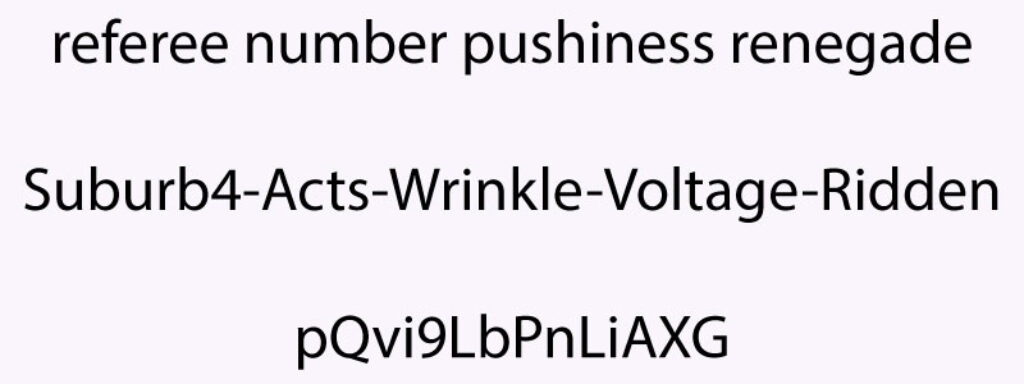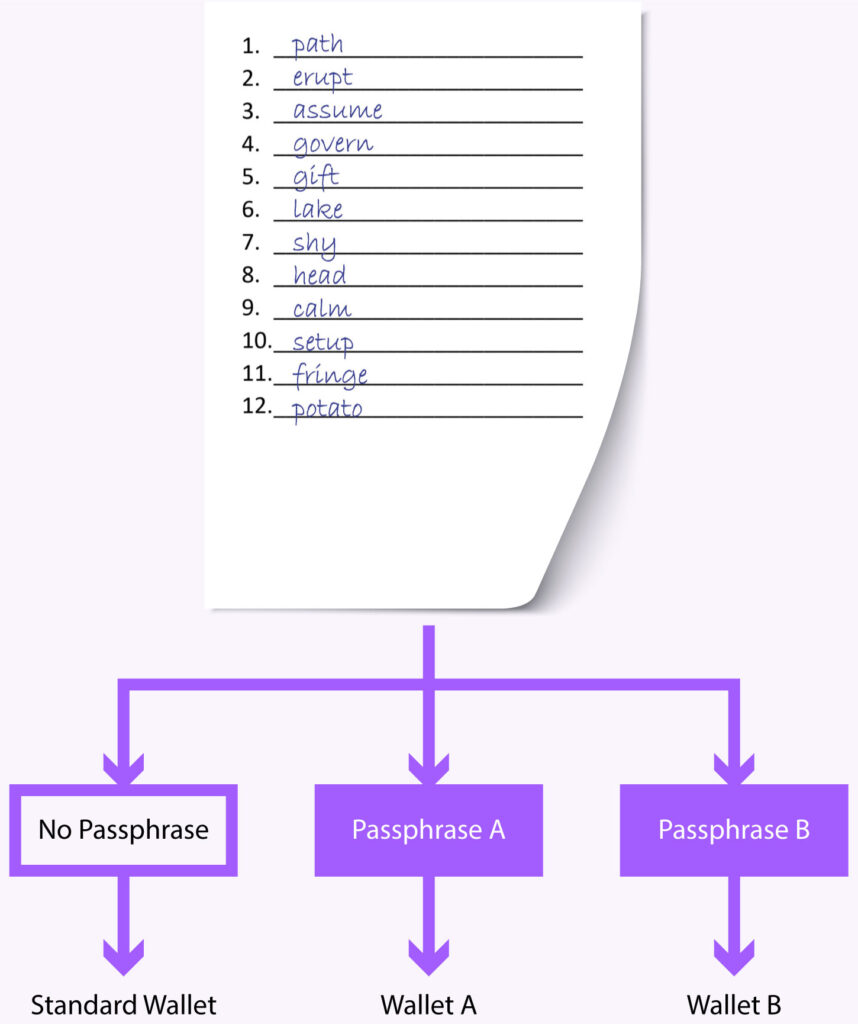In the vast expanse of Bitcoin’s digital realm, a staggering 20% of BTC remains inaccessible, largely due to lost keys—a stark reminder of security’s paramount importance. This brings us to the critical question: what is a BIP39 passphrase? Serving as your financial Fort Knox, a mnemonic passphrase is the cornerstone of Bitcoin security, ensuring only you can access your coins.
In this guide, we’ll unravel the mystery of crypto wallet passphrases, explore their pivotal role in safeguarding your Satoshis, and provide practical steps to create and store one securely. Prepare to fortify your Bitcoin vault as we delve into the essentials of digital security.
What is a BIP39 Passphrase?
A BIP39 passphrase is an optional user-created password added to your recovery phrase. This recovery phrase, typically a sequence of 12 to 24 words, acts as a master key to access your Bitcoin. The passphrase, often termed as the “25th word”, works alongside this sequence. This combination offers a robust layer of security, making your wallet virtually impregnable.

The concept originated from Bitcoin Improvement Proposal 39 (BIP39) introduced in 2013. Its mission: to transform complex cryptographic keys into human-readable formats, i.e., a sequence of words. This approach revolutionized wallet recovery processes, making them more user-friendly yet equally secure.
How Does a BIP39 Passphrase Work?
At its core, a BIP39 passphrase modifies the cryptographic process of wallet generation. Here’s a technical look at how it works:
When you enter a passphrase, the wallet software concatenates it with your seed phrase. This modified seed phrase then undergoes a cryptographic function called hashing. The hashing process produces a unique, fixed-size output. This output, in turn, generates a new master private key and, consequently, a new wallet.
What’s fascinating is that each different passphrase you use with the same seed phrase results in a completely different hash, leading to the creation of a distinct wallet. It’s akin to having several secret drawers, each opening with a different key, but all housed in the same cabinet. This capability allows for multiple, separate wallets, each hidden behind its unique passphrase, all stemming from the same seed phrase.

Benefits and Risks of Using Wallet Passphrases
In this section, we’ll explore the pros and cons of using a passphrase with your wallet, providing a balanced view to help you make informed decisions about securing your digital gold.
Enhanced Security
The security of your Bitcoin is paramount. This is where the BIP39 passphrase shines, acting as an impenetrable shield for your wallet. But how exactly does it bolster security?
Firstly, the passphrase serves as an additional layer atop your seed phrase. In the unfortunate event of your seed phrase being exposed or stolen, the passphrase is your last line of defense. Without it, the seed phrase alone is insufficient to access your funds.
This setup significantly enhances protection against brute force attacks. In such attacks, hackers use automated software to try countless combinations to crack your wallet’s code. The introduction of a passphrase exponentially increases the complexity, akin to adding millions of extra combinations.
Privacy and Anonymity
Privacy and anonymity are not just features; they’re necessities. The BIP39 passphrase plays a pivotal role here, offering a cloak of invisibility for your transactions and holdings.
Unlike standard wallets derived solely from a seed phrase, passphrase-protected wallets are hidden from plain sight. They exist in a kind of cryptographic shadow realm, accessible only to those who know the specific passphrase.
Thanks to passphrases, you can allocate funds for specific purposes in different wallets. To an outsider’s eye, these are unrelated entities. Your financial activities in one wallet remain isolated from the others, leaving no breadcrumbs connecting your diverse transactions and holdings.
In a world where financial footprints are scrutinized, such compartmentalization is invaluable. It provides the freedom to move your Satoshis around without revealing your entire financial picture.
Wallet Recovery
The ability to recover your software or hardware wallet is as crucial as safeguarding it. Here, the BIP39 passphrase plays a vital role, acting like a retriever of your digital treasure in times of need.
If you’ve employed a crypto wallet passphrase, the recovery landscape shifts. To successfully recover your wallet, you need not just the seed phrase, but also the exact passphrase you used. This combination is the lifeline to your Bitcoin holdings.
The importance of this dual-component recovery system cannot be overstated. Losing or forgetting your passphrase is akin to losing a critical piece of the puzzle. Without it, the wallet and its contents remain locked away, potentially forever.
It’s a reminder of the critical importance of securely storing your seed phrase and your passphrase.
Risk of Loss
The passphrase, while a powerful tool for security, demands an equal measure of responsibility. If forgotten, it can permanently lock you out of your wallet.
Unlike traditional banking systems, there’s no ‘Forgot Password?’ link or customer service to fall back on. Your passphrase is your sole lifeline to your Bitcoin stash. It’s a case of having ultimate control, yet with it, the ultimate responsibility.
To navigate this risk, a strategy of secure backups is crucial. Think of it as safeguarding a priceless artifact. One effective method is to use a physical, durable medium like metal to engrave your passphrase, resistant to fire and water damage.
Additionally, consider inheritance planning services. These services can provide a safety net, ensuring that your Bitcoin can be recovered or passed on, even if something happens to you.
Complexity and User Error
A BIP39 passphrase is a powerful tool, but its effectiveness hinges on user management. The passphrase needs to be complex enough to deter potential threats, yet memorable enough to avoid personal lockout.
This balancing act is where complexity breeds potential pitfalls.
A minor misunderstanding or a simple oversight in using wallet features can lead to unintended, irreversible consequences.
To mitigate these risks, meticulousness is key. Double-checking while setting up the passphrase, confirming its accuracy, and having a reliable, secure method of recording it can save a plethora of troubles. Additionally, familiarizing oneself thoroughly with the wallet’s interface and functions is vital.
False Sense of Security
The passphrase, undoubtedly, is a formidable line of defense. It adds an extra layer of security to your Bitcoin wallet, making unauthorized access considerably difficult.
But it’s not a silver bullet.
The security of your digital assets isn’t just about the strength of your passphrase; it’s about the overall hygiene of your digital and physical security practices.
Firstly, remember that security threats aren’t always external. Simple human errors, like sharing your passphrase with an untrustworthy source or exposing it to potential physical theft, can be just as perilous. Thus, maintaining strict confidentiality and secure storage of your passphrase is imperative.
Secondly, consider the broader spectrum of digital security. This includes using secure, private internet connections, keeping your software updated to protect against malware, and being vigilant against phishing scams.
Thirdly, diversification is key. Don’t put all your Satoshis in one basket, or in this case, one wallet. Using multiple wallets can spread the risk, minimizing the impact of a potential breach.
Setting Up Your BIP39 Passphrase
Here’s a straightforward guide to create a strong passphrase and ensure its safety:
- Creating Your Passphrase: Aim for complexity and uniqueness. A strong passphrase should be a mix of letters (both uppercase and lowercase), numbers, and symbols. Avoid common phrases, personal information, or anything easily guessable. Think of it as creating a secret code that only you can decipher.
- Storing Your Passphrase: Once you have your passphrase, secure storage is crucial. Writing it down on paper and keeping it in a safe, preferably in a location separate from where you store your seed phrase, is a good practice. For added security, consider using a tamper-resistant, fireproof, and waterproof container or a specialized metal backup tool designed for storing sensitive information.
- Remembering Your Passphrase: Regularly revisiting your passphrase can help in memorization. However, avoid digital storage or cloud services, as they are vulnerable to hacking. If you must use a digital tool, opt for a reputable encrypted password manager.
- Avoiding Common Mistakes: The most common pitfall is forgetting your passphrase. Regular, safe reviews can prevent this. Also, be wary of typos – even a small mistake can lock you out of your wallet. Double-check your passphrase when you set it and each time you access it.
- Backup and Recovery: Consider having a trusted person or a secure backup service know or have access to your passphrase for recovery purposes, especially in cases of emergency or unexpected events.
By following these simple yet effective steps, you can ensure that your BIP39 passphrase is not only strong but also safely stored and remembered, keeping your Bitcoin holdings secure and accessible.
Frequently Asked Questions
A BIP39 passphrase significantly enhances your Bitcoin wallet’s security. It acts as an additional, customizable layer on top of your seed phrase. Without it, even if someone obtains your seed phrase, they can’t access your wallet. The passphrase effectively creates a new set of private keys, making brute force attacks exponentially harder due to increased complexity.
A good passphrase for a Bitcoin wallet is one that is both secure and memorable. It should be a unique combination of letters (both uppercase and lowercase), numbers, and symbols, spanning at least 12 characters. Avoid common phrases, easily guessable information like birthdays or common words. A strong passphrase could be a random set of words or an uncommon phrase known only to you.
If you lose your BIP39 passphrase, accessing the wallet associated with it becomes impossible. It effectively means losing access to any Bitcoin or assets stored in that specific wallet.
The passphrase for a Bitcoin wallet is not stored digitally or on any server. Instead, it resides solely with the user. It’s a piece of information that you create and remember, and it’s crucial to keep it secure and private.
No, a passphrase is not the same as a PIN. A passphrase, in the context of Bitcoin wallets, is an extra layer of security to your wallet that works alongside your seed phrase to encrypt and protect your wallet. A PIN, on the other hand, is typically a shorter numeric code used to gain quick access to a device or software.
Conclusion
As we wrap up our exploration of the BIP39 passphrase, let’s revisit the key points that make it an indispensable tool in your Bitcoin security arsenal:
The mnemonic passphrase adds a critical layer of protection to your wallet, safeguarding it against brute force attacks and unauthorized access, even if your seed phrase is compromised. And it helps you maintain privacy and anonymity in your transactions and holdings.
But the flip side of this enhanced security is the risk of losing access to your wallet if you forget your passphrase. Both the seed phrase and the passphrase are essential for recovering your wallet. Losing either can lead to permanent loss of access to your funds.
Setting up a strong and secure BIP39 passphrase is a vital step, but it’s just the beginning of your journey in securely storing Bitcoin. For more detailed insights and practical tips, visit our comprehensive guide at How to Store Bitcoin. Here, you’ll find a treasure trove of information to ensure your digital gold remains safe and sound.
